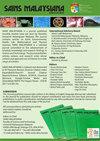马来西亚尾矿加工业许可证豁免被撤销后的对策探讨
IF 0.8
4区 综合性期刊
Q3 MULTIDISCIPLINARY SCIENCES
引用次数: 0
摘要
从尾矿渣中提取重金属和稀土元素,由于加工活动所造成的污染,对环境和工业工人造成了重大影响。土壤和尾矿渣中226Ra、232Th和40K的放射性核素浓度分别在0.31 ~ 4.97 Bqg-1和1.24 ~ 4.47 Bqg-1、0.16 ~ 11.07 Bqg-1和1.08 ~ 8.56 Bqg-1、0.22 ~ 1.24和0.18 ~ 1.32 Bqg-1范围内。放射冲击评估结果显示,年有效剂量估计在0.7 - 207.6毫西维-1之间,存在明显的过量暴露风险,而我们发现的过量终身癌症风险已超过当地监管机构规定的限值。研究结果与颁布许可豁免令之间的相关性是为了确定不遵守《原子能许可法》的影响。该研究还强调了在实施任何形式的改变以遵守新的法规之前,对工业场地进行补救的重要性。因此,该研究建议了可能的补救技术,但要考虑到每个加工厂的运行状况、污染程度和受污染场地未来可能的用途。本文章由计算机程序翻译,如有差异,请以英文原文为准。
Exploring Strategies Post-Revocation of Licensing Exemption for Malaysia's Tailing Processing Industry
The extraction of heavy metals and rare-earth elements from tailing residue has caused a significant impact towards the environment as well as the industrial workers as a result from the contamination caused by the processing activities. The radionclide concentration of 226Ra, 232Th, and 40K in soil and tailing residue were found to be within the range of 0.31 - 4.97 Bqg-1 and 1.24 - 4.47 Bqg-1, 0.16 - 11.07 Bqg-1 and 1.08 - 8.56 Bqg-1, 0.22 - 1.24 and 0.18 - 1.32 Bqg-1, respectively. The radiological impack assessment findings indicated significant overexposure risks where the annual effective dose was estimated to be within the range of 0.7 – 207.6 mSvy-1 while the excess lifetime cancer risks we found to have exceeded the limit let by the local regulatory body. The correlation between study findings and the enactment of the licensing exemption order was done to identify the effects of non-regulatory compliance to the Atomic Energy Licensing Act. The study also emphasized on the remediation importance of industrial sites before implementing any form of changes towards new regulatory adherence. Hence, the study recommeneds potential remediation techniques but taking into account the operational status of each proceesing plant, degree of contation and possible future use of the contaminated site.
求助全文
通过发布文献求助,成功后即可免费获取论文全文。
去求助
来源期刊

Sains Malaysiana
MULTIDISCIPLINARY SCIENCES-
CiteScore
1.60
自引率
12.50%
发文量
196
审稿时长
3-6 weeks
期刊介绍:
Sains Malaysiana is a refereed journal committed to the advancement of scholarly knowledge and research findings of the several branches of science and technology. It contains articles on Earth Sciences, Health Sciences, Life Sciences, Mathematical Sciences and Physical Sciences. The journal publishes articles, reviews, and research notes whose content and approach are of interest to a wide range of scholars. Sains Malaysiana is published by the UKM Press an its autonomous Editorial Board are drawn from the Faculty of Science and Technology, Universiti Kebangsaan Malaysia. In addition, distinguished scholars from local and foreign universities are appointed to serve as advisory board members and referees.
 求助内容:
求助内容: 应助结果提醒方式:
应助结果提醒方式:


